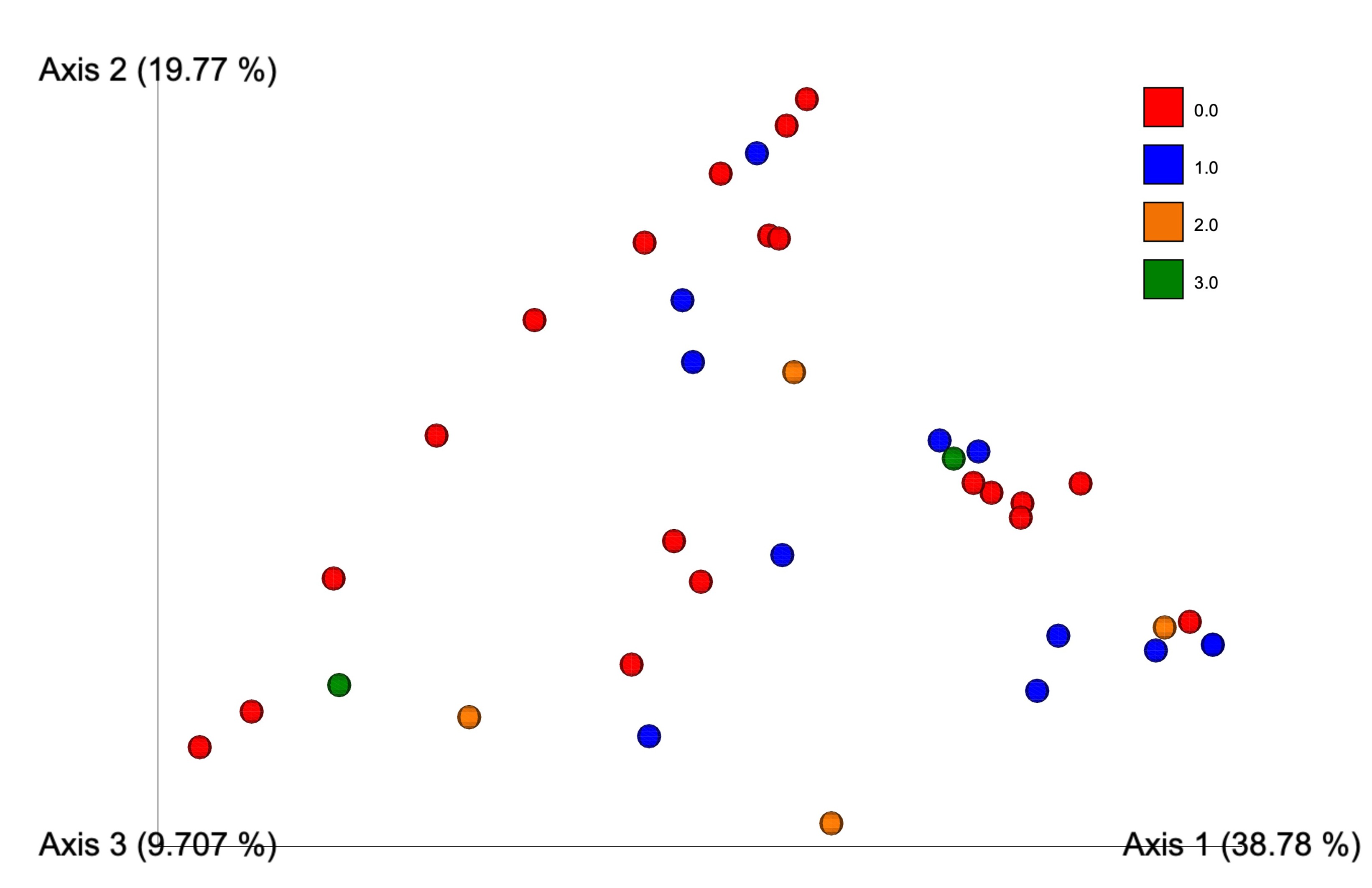Back
Poster Session C - Monday Afternoon
C0367 - Diversity of the Fungal Mycobiome Across Endo-Histologic Activity and Treatment-Associated Effects in Ulcerative Colitis
Monday, October 24, 2022
3:00 PM – 5:00 PM ET
Location: Crown Ballroom

Katie Hsia, MD
Tufts Medical Center
Boston, MA
Presenting Author(s)
Katie Hsia, MD, May Fu, DO, Laleh Montaser Kouhsari, MD, Khalid Algarrahi, MD, Hannah Chen, MD, Dominique Michaud, MD, Sushrut Jangi, MD
Tufts Medical Center, Boston, MA
Introduction: Fungi represent a highly immunologically reactive component of the gut microbiota, however their dynamics during varying stages of inflammation and treatment in ulcerative colitis (UC) remain poorly understood. A recent study of fecal microbial transplantation in UC demonstrated that fungal diversity may be associated with progression to remission in the recipient. We aimed to characterize the diversity of the mycobiome in UC across the spectrum of endo-histologic activity alongside treatment-mediated effects.
Methods: We performed a retrospective cohort study, utilizing data from The Study of a Prospective Adult Research Cohort with IBD, established by the Crohn’s and Colitis Foundation. This national cohort includes clinical metadata, endoscopic scores, digitized histologic sections, medication use, and stool metagenomics. Internal Transcribed Spacer based deep sequencing of fungal rDNA from fecal samples was analyzed using Quantitative Insights Into Microbial Ecology 2. Alpha and beta diversity (measured using faith phylogenic diversity or unweighted Unifrac) was compared among (1) patients with complete endoscopic remission vs endoscopic activity, (2) patients with endo-histologic remission vs endo-histologic activity, and (3) patients naïve to biologic medications vs patients actively treated with biologic medications.
Results: Among 85 samples with fungal sequencing data, endoscopic data (defined by Mayo endoscopic score [MES]) was available for 32 samples. Histologic classification (defined by Nancy histologic index [NHI]) was prospectively analyzed among 31 samples. Patients with endoscopic remission (MES 0, n=20) had no difference in alpha diversity (3.22 v 3.06, p=0.938, H=0.0379) compared to any endoscopic activity (MES >0, n=12). No difference in beta diversity was observed (p=0.301). No difference in alpha diversity was observed between patients on (n=43) or off (n=15) biologics (3.44 v 3.21, p=0.411, H=0.676). Alpha diversity was similar between endo-histologic activity (n=13) and endo-histologic remission (n=18), (3.22 v 2.97, p=0.378, H=0.776), alongside similar beta diversity (p=0.781).
Discussion: Fungal diversity indices were similar in UC patients across the spectrum of endo-histologic activity and treatment effect. Future analyses should examine these indices in larger cohorts of patients as well as evaluate differences in abundance of fungal species across the spectrum of endo-histologic activity and treatments.

Disclosures:
Katie Hsia, MD, May Fu, DO, Laleh Montaser Kouhsari, MD, Khalid Algarrahi, MD, Hannah Chen, MD, Dominique Michaud, MD, Sushrut Jangi, MD. C0367 - Diversity of the Fungal Mycobiome Across Endo-Histologic Activity and Treatment-Associated Effects in Ulcerative Colitis, ACG 2022 Annual Scientific Meeting Abstracts. Charlotte, NC: American College of Gastroenterology.
Tufts Medical Center, Boston, MA
Introduction: Fungi represent a highly immunologically reactive component of the gut microbiota, however their dynamics during varying stages of inflammation and treatment in ulcerative colitis (UC) remain poorly understood. A recent study of fecal microbial transplantation in UC demonstrated that fungal diversity may be associated with progression to remission in the recipient. We aimed to characterize the diversity of the mycobiome in UC across the spectrum of endo-histologic activity alongside treatment-mediated effects.
Methods: We performed a retrospective cohort study, utilizing data from The Study of a Prospective Adult Research Cohort with IBD, established by the Crohn’s and Colitis Foundation. This national cohort includes clinical metadata, endoscopic scores, digitized histologic sections, medication use, and stool metagenomics. Internal Transcribed Spacer based deep sequencing of fungal rDNA from fecal samples was analyzed using Quantitative Insights Into Microbial Ecology 2. Alpha and beta diversity (measured using faith phylogenic diversity or unweighted Unifrac) was compared among (1) patients with complete endoscopic remission vs endoscopic activity, (2) patients with endo-histologic remission vs endo-histologic activity, and (3) patients naïve to biologic medications vs patients actively treated with biologic medications.
Results: Among 85 samples with fungal sequencing data, endoscopic data (defined by Mayo endoscopic score [MES]) was available for 32 samples. Histologic classification (defined by Nancy histologic index [NHI]) was prospectively analyzed among 31 samples. Patients with endoscopic remission (MES 0, n=20) had no difference in alpha diversity (3.22 v 3.06, p=0.938, H=0.0379) compared to any endoscopic activity (MES >0, n=12). No difference in beta diversity was observed (p=0.301). No difference in alpha diversity was observed between patients on (n=43) or off (n=15) biologics (3.44 v 3.21, p=0.411, H=0.676). Alpha diversity was similar between endo-histologic activity (n=13) and endo-histologic remission (n=18), (3.22 v 2.97, p=0.378, H=0.776), alongside similar beta diversity (p=0.781).
Discussion: Fungal diversity indices were similar in UC patients across the spectrum of endo-histologic activity and treatment effect. Future analyses should examine these indices in larger cohorts of patients as well as evaluate differences in abundance of fungal species across the spectrum of endo-histologic activity and treatments.

Figure: Beta diversity as measured by weighted unifrac of Mayo Endoscopic Score in patients with ulcerative colitis.
Disclosures:
Katie Hsia indicated no relevant financial relationships.
May Fu indicated no relevant financial relationships.
Laleh Montaser Kouhsari indicated no relevant financial relationships.
Khalid Algarrahi indicated no relevant financial relationships.
Hannah Chen indicated no relevant financial relationships.
Dominique Michaud indicated no relevant financial relationships.
Sushrut Jangi indicated no relevant financial relationships.
Katie Hsia, MD, May Fu, DO, Laleh Montaser Kouhsari, MD, Khalid Algarrahi, MD, Hannah Chen, MD, Dominique Michaud, MD, Sushrut Jangi, MD. C0367 - Diversity of the Fungal Mycobiome Across Endo-Histologic Activity and Treatment-Associated Effects in Ulcerative Colitis, ACG 2022 Annual Scientific Meeting Abstracts. Charlotte, NC: American College of Gastroenterology.

